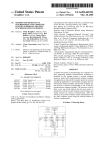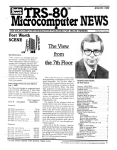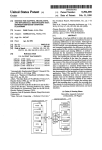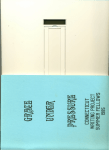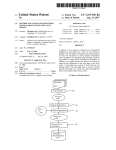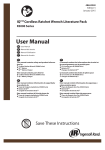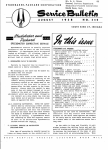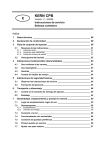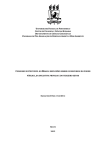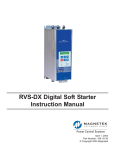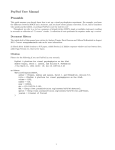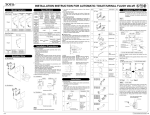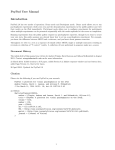Download Method and apparatus for synchronization of two computer systems
Transcript
US006671702B2
(12) United States Patent
Kruglikov et al.
(54)
(75)
METHOD AND APPARATUS FOR
SYNCHRONIZATION OF TWO COMPUTER
SYSTEMS BY EXECUTING A
SYNCHRONIZATION PROCESS AT A
PORTABLE COMPUTER
Inventors:
Vitaly Kruglikov, Mountain View, CA
(US); Roger Flores, Redwood City, CA
(US); Rob Haitani, San Jose, CA (US);
Monty Boyer, Saratoga, CA (US); Ron
Marianetti, Morgan Hill, CA (US); Ain
McKendrick, Menlo Park, CA (US);
Art Lamb, Tiburon, CA (US)
(73) Assignee: PalmSource, Inc., Sunnyvale, CA (US)
US 6,671,702 B2
(10) Patent N0.:
(45) Date of Patent:
5,544,356 A
5,574,859 A
Dec. 30, 2003
8/1996 Robinson et al.
11/1996 Yeh
(List continued on next page.)
OTHER PUBLICATIONS
Cobb et al., “Paradox 3.5 Handbook 3.sup.rd Edition”
Bantam (1991), pp. 803—816.
Al?eri, “The best book of: Wordperfect 5 .0”, Hayden Books
(1988), pp. 153—165 and 429—435.
User Manual For PC—Link for the B.O.S.S. and the PC—link
for the B.O.S.S, Traveling Software, Inc. (1989).
User Manual For Connectivity Pack for the HP 95LX,
Hewlett Packard Company (1991).
Organizer Link II Operation Manual, Sharp Electronics
Corporation, No Date.
(*)
Notice:
Subject to any disclaimer, the term of this
patent is extended or adjusted under 35
U.S.C. 154(b) by 0 days.
(21) Appl. No.: 10/234,615
Sep. 3, 2002
(22) Filed:
Prior Publication Data
(65)
“Open Network Cornputing—Technical Overview”, Sun
Technical Report, Sun Microsysterns, Inc. pp. 1—32 (1987).
“Automatically Synchronized Objects”, Research Disclo
sure #29261, p. 614 (Aug. 1988). No Copy Available.
“FRx Extends Reporting Power Of Platinum Series: (IBM
Desktop Software’s Line of Accounting Software)” Doug
Dayton, PC Week, v. 8, No. 5, p. 29(2), Feb. 1991.
Primary Examiner—Hosain T. Alam
US 2002/0198900 A1 Dec. 26, 2002
(57)
ABSTRACT
Related US. Application Data
A method and system for synchronizing two computer
(63)
(51)
(52)
(58)
Continuation of application No. 09/590,541, ?led on Jun. 8,
2000, which is a continuation of application No. 09/016,076,
systems supporting multiple synchronization techniques is
?led on Jan. 30, 1998, now Pat. No. 6,205,448.
system is loaded with synchronization transport modules.
An application on the portable computer system is executed
causing the application to automatically recognize the syn
chronization transport modules. The portable computer sys
Int. Cl.7 ........................ .. G06F 17/30; G06F 15/16
US. Cl. ........................ .. 707/201; 707/10; 709/248
Field of Search ........................ .. 707/10, 201, 202,
707/204; 709/248
A
A
A
A
A
synchronization transport modules. The selection could be
synchronize with the second computer system using a par
U.S. PATENT DOCUMENTS
5,001,628
5,355,476
5,379,057
5,463,772
5,537,592
tem receives a selection corresponding to one of the two
from a user and would indicate that the user prefers to
References Cited
(56)
described. In one example system, a portable computer
ticular method of external communication. After the
selection, the portable computer system synchronizes with
3/1991 Johnson et al.
-
“V1994 Fukumura
the othizr computer system using the selected method of
1/1995 clough et a1‘
10/1995 Thompson et al.
externa communication.
7/1996 King et al.
20 Claims, 11 Drawing Sheets
Lcomoun SETUP
[Xi]
SELECT THE CONDUITS TO RUN
DURING MODEM HOTSYNC
[1]
(FOR PILOT DESKTOP 2.0 ONLY)
Z! ADDRESS
IE}
We
E!
{X} COMM TEST
910
E] DATEBOOK
IX] HOTSYNC
E] MAIL
IX] MEMO PAD
US 6,671,702 B2
Page 2
US. PATENT DOCUMENTS
5,696,702 A
12/1997 Skinner et a1.
5729 452 A
31998 s 'th 1 1.
9/1999 Che/mfg 6‘ ‘1L
5,592,669 A
1/1997 Robinson 6161.
’
’
5,598,536 A
1/1997 Slaughter, 1116161.
5,953,507 A
5,630,081 A
5/1997 Rybicki et a1_
6,205,448 B1
5,666,530 A
9/1997 Clark et a1,
6,330,618 B1
/
m‘
e a
3/2001 Krughkov et a1. ........ .. 707/200
12/2001 Hawkins et a1.
U.S. Patent
Dec. 30, 2003
Sheet 2 0f 11
US 6,671,702 B2
210
PROCESSOR
230
215vA
REGISTER 1
217
REGISTER 2
BATTERY
BACKED
219
REGISTER 3
MEMORY
‘
‘
’
i
250
<——
Y
‘
‘
l
II;
'I1
I
1
1
Y
v
VOLAT‘LE
MEMORY
FLAT PANEL
DlSPLAY
220
240
FIG. 2
>
U.S. Patent
Dec. 30, 2003
Sheet 3 0f 11
US 6,671,702 B2
@
i
1
COMBINE REGISTER
$310
VALUES TOGETHER
w
l
l
V
HASH MEMORY
CONTENTS
TOGETHER
I
I
I
FIG. 3
$350
U.S. Patent
Dec. 30, 2003
Sheet 4 0f 11
US 6,671,702 B2
Y
OPEN DESKTOP
COMPANION PROGRAM
V
SELECT "USERS" MENU
$420
SELECT "PROFILE" ITEM
N/T“‘I30
Y
CREATE A NEW PROFILE
AND NAME THE NEW PROFILE
I
1
Y
EDIT THE PROFILE
INFORMATTON
FIG. 4
V450
U.S. Patent
Dec. 30, 2003
Sheet 5 0f 11
US 6,671,702 B2
PROFILES
SELECT A PROFILE:
OK
?EW...
QELETE...
RENAME".
_U_SERS...
?ELP
FIG. 5A
U.S. Patent
Dec. 30, 2003
Sheet 6 6f 11
US 6,671,702 B2
NEW PROFILE
X
ENTER A NEW PROFILE NAME:
OK
FIG. 5B
CANCEL
U.S. Patent
Dec. 30, 2003
Sheet 7 0f 11
TNSERT NEW PORTABLE
COMPUTER !N THE
$610
CRADLE AND INITIATE
A SYNCHRONIZATTON
%7
SELECT "PROFlLES“
FROM THE
“NEW USER“ DIALOG
!
V
SELECT A PROFTLE TO
DOWNLOAD INTO
THE PORTABLE
_ COMPUTER
i
j
DOWNLOAD THE
PROFlLE TNTO THE
PORTABLE COMPUTER
WITHOUT ASSIGNING AN
TDENTIFIER TO THE
PORTABLE COMPUTER
l
1
FIG. 6
\_/‘\620
US 6,671,702 B2
U.S. Patent
Dec. 30, 2003
Sheet 8 0f 11
US 6,671,702 B2
CUSTOM
[XI
PHOTO JlM
v
CONDUlT
ACTION
DATE BOOK
SYNCHRONEZE THE FTLEs
ADDRESS BOOK
SYNCHRONlZE THE FILES
TO DO LlST
SYNCHRONIZE THE FILES
MEMO PAD
SYNCHRONIZE THE FILES
MAIL
SYNCHRONIZE THE FILES
EXPENSE
msTALL
SYSTEM
SYNCHRON‘ZE THE HLEs
ENABLED
PILOT OVERWRITES DESKTOP
FIG. 7
DQNE
QHANGE
DEFAULT
?ELP
U.S. Patent
Dec. 30, 2003
Sheet 9 0f 11
US 6,671,702 B2
CHANGE HOTSYNC ACTION
El
—HOTSYNC ACTION FOR TO DO LIST
Q 3 g Q) SYNCHRONiZETHE FILES
Q " g C) DESKTOP OVERWRITES PILOT
OK
QANCEL
?ELP
Q _) g Q PILOT OVERWRITES DESKTOP [3 SET AS DEFAULT
Q g O00 NOTHlNG
FIG. 8
U.S. Patent
Dec. 30, 2003
Sheet 10 0f 11
US 6,671,702 B2
cowoun SETUP
[X]
SELECT THE CONDUITS TO RUN
DURING MODEM HOTSYNC
OK
(FOR PILOT DESKTOP 2.0 ONLY)
’
IX] ADDRESS
QANCEL
IX] CALC
[X] COMM TEST
910‘
HELP
[X] DATEBOOK
[X1 HOTSYNC
[E MAIL
IX] MEMO PAD
FIG. 9
U.S. Patent
Dec. 30, 2003
OTHER
APPLICATION
Sheet 11 0f 11
I
US 6,671,702 B2
SYNCHRONIZATION
I
APPLICATION
0
1
‘I ?
DL SERVER
1922
A
SYNCHRON
IZATION
TRANSPORT
ADAPTATION
LAYER
CRADLE
TRANSPORT
LAYER
NETWORK
SYNC
MODEM
SYNC
TRANSPORT
TRANSPORT
022
w
I
I
I
V
k
I
‘I‘v.!:
I
l
I
STACK
I050
I
TCP/IP
AND PPP
I
v
I
k
SERIAL LINK DRIVER
I 060
IV
SERIAL PORT
1 070
1 000
FIG. 10
SYNC
TRANSPORT
I047
I
I
I
I
I
I
INFRARED
‘I - Z
US 6,671,702 B2
1
2
FIG. 5A illustrates a diagram of a graphical user interface
METHOD AND APPARATUS FOR
SYNCHRONIZATION OF TWO COMPUTER
SYSTEMS BY EXECUTING A
SYNCHRONIZATION PROCESS AT A
PORTABLE COMPUTER
dialog box for modifying pro?les.
FIG. 5B illustrates a diagram of a graphical user interface
dialog box for creating a neW pro?le.
FIG. 6 illustrates a How diagram describing hoW pro?le is
doWnloaded into a portable computer system.
FIG. 7 illustrates a diagram of a graphical user interface
This is a continuation of 09/590,541 ?led Jun. 8, 2000
Which is a continuation of 09/016,076, ?led Jan. 30, 1998
now US. Pat. No. 6,205,448.
dialog box for modifying conduits.
FIG. 8 illustrates a diagram of a graphical user interface
dialog box for setting conduit behavior.
This application claims bene?t of and priority to the
following previously ?led applications: The present appli
FIG. 9 illustrates a diagram of a screen display for setting
conduit behavior on a portable computer system.
FIG. 10 illustrates the softWare architecture of a portable
cation is a continuation of US. Application No. 09/590,541,
entitled “Method and Apparatus for Synchronization of TWo
Computer Systems Supporting Multiple Synchronization
Techniques by Using Synchronization Transport Modules”
computer system With an expandable synchronization trans
15
port adaptation layer.
?led by Vitaly Kruglikov, et al. on Jun. 8, 2000 and issuing
as US. Pat. No. 6,505,215, Which is a continuation of US.
DETAILED DESCRIPTION OF THE
PREFERRED EMBODIMENT
Application No. 09/016,076, entitled “Method and Appara
tus of Synchronizing TWo Computer Systems Supporting
computer systems is disclosed. In the folloWing description,
A method and apparatus for synchronizing tWo different
Mutiple Synchronization Techniques By Using Synchroni
for purposes of explanation, speci?c nomenclature is set
forth to provide a thorough understanding of the present
zation Transport Modules” ?led by Vitaly Kruglikov, et al.
on Jan. 30, 1998 and issuing as US. Pat. No. 6,205,448.
invention. HoWever, it Will be apparent to one skilled in the
art that these speci?c details are not required in order to
FIELD OF THE INVENTION
The present invention relates to the ?eld of portable
practice the present invention. For example, the present
25
computer systems. In particular the present invention dis
closes improved methods for synchronization of tWo differ
ent computer systems.
invention has been described With reference to synchroni
zation betWeen a portable computer system and a desktop
personal computer system. HoWever, the same techniques
can easily be applied to other types of computer devices.
General Synchronization System Architecture
BACKGROUND OF THE INVENTION
FIG. 1 illustrates a conceptual diagram of computer
synchronization system betWeen a portable system 110 and
Portable computer systems have become valuable infor
mation appliances that provide important information When
a personal computer system 150. The portable computer
ever and Wherever the user needs it. It has become apparent
system 110 may be any type of small microprocessor based
that one of the most important features of portable computer
35 computer system such as a cellular phone or a handheld
systems is the ability to share data With larger desktop
personal information manager.
personal computers. Several earlier patents such as “Method
And Apparatus for Synchronizing Information On TWo
Different Computer Systems” ?led Oct. 18, 1995 With Ser.
No. 08/544,927, “Extendable Method And Apparatus For
In FIG. 1 both the handheld computer system 110 and the
personal computer system 150 are running calendar pro
Synchronizing Multiple Files On TWo Different Computer
computer system 110 or the data on the desktop personal
computer system calendar program 155 on the personal
computer system 150. Then, at some later point, the user
gram. With a synchronization system, the user can alter the
data on both the calendar program 115 and on the handheld
Systems” ?led Oct. 13, 1995 With Ser. No. 08/542,055, and
“Method And Apparatus for SynchronizingAPortable Com
puter System With a Desktop Computer System” ?led Jan.
30, 1997 With Ser. No. 08/792,166 have addressed some of
the issues involved in the synchronization of tWo different
should be able to reconcile the tWo different calendar data
45
bases by coupling the tWo computer system together using
desirable to improve the synchronization methods used With
communication link 140 and requesting a synchronization.
The synchronization process combines the data from the
modi?ed personal computer calendar 155 and the data from
the modi?ed hand held calendar 115 into a single reconciled
calendar. The reconciled calendar is then placed into both
the handheld computer system 110 and the personal com
portable computer systems.
puter system 150.
computer systems.
As the portable computer systems have been put to use out
in the ?eld, some draWbacks in the current synchronization
procedures have been identi?ed. It Would therefore be
Details on implementing a basic synchronization system
are set forth in the patents “Method And Apparatus for
BRIEF DESCRIPTION OF THE DRAWINGS
The objects, features and advantages of the present inven
55
tion Will be apparent to one skilled in the art, in vieW of the
folloWing detailed description in Which:
FIG. 1 illustrates a conceptual diagram of computer
synchronization system betWeen a portable system 110 and
a personal computer system 150.
FIG. 2 illustrates a conceptual diagram of a typical
Apparatus for Synchronizing A Portable Computer System
With a Desktop Computer System” ?led Jan. 30, 1997 With
Ser. No. 08/792,166 Which are hereby incorporated by
computer operating system.
FIG. 3 illustrates a How diagram describing a method of
generating a random number seed.
FIG. 4 illustrates a How diagram describing a method of
creating a portable computer pro?le.
Synchronizing Information On TWo Different Computer
Systems” ?led Oct. 18, 1995 With Ser. No. 08/544,927,
“Extendable Method And Apparatus For Synchronizing
Multiple Files On TWo Different Computer Systems” ?led
Oct. 13, 1995 With Ser. No. 08/542,055, and “Method And
reference.
65
Random Number Generation
To simplify the synchronization process, each record on
both the personal computer system and the portable com
US 6,671,702 B2
3
4
puter system has an identi?cation number. Corresponding
records on the personal computer system and the portable
computer system Will have matching identi?cation numbers.
Thus, to quickly locate corresponding records during a
variables, its contents are semi-random. This semi-random
area of memory can be logically combined to produce a
random seed.
FIG. 3 illustrates a summary of a method of generating a
synchronization, the synchronization program only needs to
?nd records having matching identi?cation numbers.
Referring to the synchroniZation system of FIG. 1, it is
random number seed in a portable computer system that has
just been turned on. First, the contents of the processor’s
internal register are logically combined. (The registers are
apparent that in the time betWeen synchroniZations, neW
records may be created on both the personal computer
preserved. Next, the register-based value is then logically
combined ?rst such that their initial state at poWer up is
system and the portable computer system. To prevent an
incorrect correlation, neW unique record identi?ers must be
assigned to neW records created on either system. To prevent
the same record identi?er from being created on both the
personal computer system and the portable computer
system, a series of random numbers are needed for both 15
systems. Methods of generating a series of random numbers
exist, hoWever an initial random number seed is required.
Thus, a robust random number seed is needed for both the
combined With the contents of a portion of the memory that
contains semi-random values. The result is a random number
seed that can be used to generate a series of random
numbers. In one embodiment, the random number seed is
only initialiZed after a processor reset. All subsequent ran
dom numbers are created by applying a random number
algorithm to the random number seed.
SynchroniZation Pro?les
portable and desktop computer systems.
When a company adopts a particular computer technology
for company Wide usage, system administrators need tools
There are many knoWn methods of generating random
number seeds on personal computers such as counting the
to quickly con?gure the neWly adopted computer technol
ogy. For example, When a neW program is adopted for use
time that passes betWeen successive keystrokes. HoWever, in
a pen based portable computer system, it is not as easy to
on companies personal computers, system administrator
generate random numbers. The problem is compounded by
desire the ability to install and con?gure the neW program
ber or a neW appointment.
company-Wide usage, system administrators need to be able
The present invention proposes a method of generating
random numbers in such a portable computer system. Refer
ring to FIG. 2, a block diagram of one possible embodiment
of a portable computer system is illustrated. Referring to the
present invention introduces the concept of a “user pro?le”
for alloWing a number of portable computer systems to be
the fact that the very ?rst action Which a user may perform 25 across the company’s local area netWork
after turning on a portable computer system is to enter a neW
The same principal applies to portable computer systems.
record to store a recently acquired information phone num
When a company adopts a portable computer system for
to quickly con?gure such portable computer systems. The
initialiZed With the same information.
block diagram of FIG. 2, the portable computer system
includes a main processor for performing processing instruc
tions. The processor is coupled to volatile memory system,
a battery backed memory system, and a display through a
computer bus.
When the portable computer is turned off, the contents of
the battery backed memory is retained for future reference.
35
FIG. 4 describes the steps of setting up a user pro?le.
Initially, the system administrator opens up a desktop com
panion program on a personal computer system. The admin
istrator then selects a “users” menu Where neW users may be
created. Instead of creating a neW user, the administrator
selects a button for “pro?les” to open a pro?les dialog.
FIG. 5A illustrates one possible embodiment of a pro?les
information When the portable computer system is turned
dialog box. The pro?les dialog box alloWs pro?les to be
created (neW), renamed, and deleted. (The Users button
off. HoWever, the contents of the volatile memory begin to
decay once the portable computer system is turned off.
When the portable computer is turned back on, the volatile
alloWs the user to move directly to the dialog box listing all
the knoWn users if that is What the user really Wanted.)
Referring to FIGS. 4 and 5, the user selects the neW button
Other implementations may use ?ash memory to store
45
memory Will contain modi?ed version of What volatile
memory contained When the battery Was turned off. Since
different memory cells decay at different rates, the contents
of the volatile memory Will be someWhat random. If a
sufficient number of locations from the volatile memory are
logically combined, then a random value can be created.
One method of logically combining the data Would be to
to create a neW pro?le. This causes a pop-up dialog box to
request a name for the neW pro?le as illustrated in FIG. 5B.
A name (such as “salesperson pro?le”) is entered and a neW
empty pro?le is created With that name. A pro?le is very
similar to a user in that it is associated With a set of data ?les
used during synchroniZation except that pro?le is not asso
ciated With any speci?c user or portable computer system.
The system administrator then returns to the main desktop
companion program and edits the information associated
exlcusive-OR (XOR) the data together. Another method of
creating a random value Would be to add the data together
such that over?oWs create a random pattern in the accumu
55
lator. To further randomiZe the value, the contents of the
processor’s internal registers can be combined to generate a
?nal random number seed.
In one embodiment of a portable computer system, all the
memory is battery backed such that there is no memory
copied into the neW user pro?le. For example, if the system
administrator has already entered all the company phone
numbers into his oWn account, he can copy the address
information from his oWn address database into a address
database associated With the pro?le. Furthermore, informa
tion can be imported from external sources into the pro?le
database. Thus, if the system administrator has a list of the
company’s customers, this customer database can be
decay to cause random values. In such a system, an area of
memory that is used to store temporary variables can be used
to provide semi-random values. Speci?cally, an area of
memory that is used to store temporary values is de?ned as
“dynamic memory.” The dynamic memory area is shared by
all the different applications. Since area is shared by several
different applications and stores miscellaneous temporary
With the neW pro?le. Information from existing users can be
imported into the pro?le for sales people.
65
After a pro?le has been created, the pro?le can be used to
initialiZe neW portable computer systems before the portable
computer systems are distributed to end users. FIG. 6
US 6,671,702 B2
5
6
illustrates a How diagram that describes hoW neW portable
computers are initialized. First, the system administrator
selected When modifying a conduit’s behavior, then the
conduit’s behavior Will be modi?ed for every future syn
places the neW portable computer system in a synchroniza
tion cradle connected to the personal computer storing the
pro?le and requests a synchronization. Since the portable
computer system has not been used, a “neW user” dialog box
chronization. HoWever, if the a “set as default” check box is
not selected, then the modi?cation to the conduit’s behavior
Will only affect the next synchronization. After the ?rst
synchronization, the conduit Will revert back to the default
Will request a name for the neW portable computer system.
Instead of entering a neW name, the system administrator
“synchronize” setting. This feature is useful if a user Wishes
to do a one time load of a fresh database, but then synchro
selects a “pro?les” button that brings up a pro?le dialog box.
The system administrator then selects the pro?le to doWn
nize the tWo databases in every future synchronization.
As set forth in the patent “Method And Apparatus for
10
load into the portable computer. The personal computer then
doWnloads all the information associated With the pro?le
into the portable computer. HoWever, no name is assigned to
the portable computer system. In one embodiment, the
pro?le information may include speci?c con?guration infor
Synchronizing A Portable Computer System With a Desktop
Computer System” ?led Jan. 30, 1997 With Ser. No. 08/792,
166, the portable computer system can be synchronized With
a desktop personal computer system across a telephone line.
15
mation such as netWork con?guration and dial-up numbers
as Well as the set of preloaded databases such as the
company’s telephone directory. The precon?gured portable
computer system can then be give to a user. It should be
This can be performed by directly connecting to the desktop
personal computer With a modem or connecting to the
desktop computer through a LAN connection made With a
modem-based PPP connection. In such a situation, the speed
of the synchronization Will be limited by the modem com
munication speed. To minimize the synchronization time,
noted that several portable computer systems may be ini
tialized using the same pro?le.
synchronization behavior When the synchronization is being
When a user that receives a precon?gured portable com
performed across a modem link. This feature is con?gured
puter system ?rst synchronizes the portable computer sys
on the portable computer system since the remote desktop
personal computer is not accessible.
FIG. 9 illustrates a modem synchronization con?guration
the present invention also provides a method of altering the
tem With a personal computer system, the neW user dialog
Will appear since no name Was associated With the portable 25
computer system.
Synchronization Control
screen that may be displayed on a portable computer system.
The con?guration screen of FIG. 9 alloWs the user to select
Which conduits Will be executed during a modem based
As set forth in the patent “Extendable Method And
synchronization. When a remote synchronization begins, the
remote desktop personal computer Will query the portable
Apparatus For Synchronizing Multiple Files On TWo Dif
ferent Computer Systems” ?led Oct. 13, 1995 With Ser. No.
computer system as to Which Thus, the user can shorten time
needed to perform a synchronization by only selecting the
08/542,055, a synchronization system is can be designed
Wherein different applications or databases are synchronized
conduits that synchronized the desired information.
using individually tailor synchronization “conduits.”
HoWever, it has been determined that not all the installed
Remote Dialog Box Dismissing
35
his individual needs. To adjust the conduit execution, the
As described in the previous section, a portable computer
can be remotely synchronized With a desktop personal
computer system using a modem. Alternatively, a portable
computer may also remotely synchronize With a desktop
personal computer system across a LAN using netWork
protocols. In both situations, the user is physically far from
user opens a custom synchronization control dialog box as
the desktop personal computer.
conduits should be handled in the exact same manner.
A revised synchronization system has been proposed
Wherein each conduit may be treated differently.
Speci?cally, a user may adjust the conduit execution to suit
illustrated in FIG. 7. The custom synchronization control
dialog alloWs a user to change the synchronization control of
In the patent “Extendable Method And Apparatus For
Synchronizing Multiple Files On TWo Different Computer
an individual conduit or to restore default synchronization
settings. To modify the behavior of a speci?c conduit, the
Systems” ?led Oct. 13, 1995 With Ser. No. 08/542,055, the
45
user selects the conduit and selects the “change” button to
top personal computer. If a problem occurs during the
synchronization, the synchronization conrol program Will
normally display a dialog box on the desktop personal
computer. HoWever, if the portable computer user is syn
bring up a conduit change dialog.
FIG. 8 illustrates one possible conduit change dialog box.
The change dialog box alloWs the conduit to behave in four
different Ways: synchronization, desktop overWrite, portable
chronizing from a remote location, the user Will not be able
overWrite, and inactive. The synchronization setting is the
default method of operation Wherein the corresponding
to respond to dialog boxes displayed on the remote personal
computer system.
databases on both the desktop and portable are reconciled.
To prevent a deadlock due to dialog boxes that are not
The desktop overWrite setting alloWs the contents of the
desktop personal computer database for the that particular
acted upon, the present invention introduces dynamic dialog
55
conduit to overWrite the portable computer’s database. That
setting Would be useful if all updates to that particular
database are performed on the desktop personal computer.
Wherein the contents of the portable computer system over
Writes the desktop personal computer. Finally, the inactive
setting prevents that particular conduit from executing. This
tually pop and the callback routine Will dismiss the dialog
box. If the dialog box is dismissed by a user, then the timer
is useful When the user is not using the associate application.
that Was set Will be killed.
By not performing executing a conduit, the synchronization
as default” check box. If the a “set as default” check box is
boxes. Such dynamic dialog boxes are designed to auto
matically dismiss themselves if there is no response Within
a predetermined time period. To dismiss itself, a dynamic
dialog box sets a timer that Will execute a callback routine
in the dialog box. If a dialog box is not dismissed by a user
at the desktop personal computer, then the timer Will even
The portable computer overWrite setting is the opposite
time Will be reduced and memory space Will be saved.
Referring to FIG. 8 it should be noted that there is a “set
main synchronization control program resides on the desk
65
Synchronization Transport Adaptation Layer
Different users of portable computer systems synchronize
their portable computers With personal computers in differ
US 6,671,702 B2
7
8
ent Ways. For example, one user may always synchronize
transport handles synchronization directly betWeen a serial
their portable computer With their desktop personal com
puter using a cradle coupled to the desktop personal com
puter. Another user may alWays be travelling and synchro
nizes With his desktop personal computer using a modem or
port on the portable computer system and a serial port on the
a direct connection through a computer netWork. Yet another
user may Wish to synchronize using an infrared ports that are
port handles synchronization directly betWeen the portable
computer system and a desktop computer system using
available on both the portable computer system and the
TCP/IP netWorking. The netWork synchronization use a
TCP/IP on a host personal computer system to connect With
a target desktop personal computer connected across a
desktop computer system.
The second synchronization transport is a netWork syn
chronization transport. The netWork synchronization trans
desktop personal computer. In the future, Wireless packet
radio netWorks may become pervasive alloWing a neW
method of remote synchronization to become available. To
10
computer netWork. Alternatively, the netWork synchroniza
tion may use a TCP/IP and PPP stack on the portable
accommodate all these different synchronization methods,
the present invention introduces a synchronization transport
computer such that a modem connected to the serial port of
the portable computer system establishes a PPP link With
adaptation layer.
The synchronization transport adaptation layer provides a
15
single consistent interface betWeen a synchronization pro
gram residing on a portable computer system and a plurality
of different methods of external communication. FIG. 10
illustrates the architecture of a portable computer system
can be found in the US. patent application “Method And
Apparatus for Synchronizing A Portable Computer System
With a Desktop Computer System” ?led Jan. 30, 1997 With
Ser. No. 08/792,166 Which is hereby incorporated by refer
implementing a synchronization transport adaptation layer.
Referring to FIG. 10, the synchronization application
ence.
If an infrared device is coupled to the serial port of the
communicates With a BL server (Desktop link server) that
portable computer system then the synchronization applica
acts as a single uni?ed communication interface for the
synchronization application. The DL server communicates a
tion can use the infrared synchronization transport module.
The infrared synchronization transport module implements
plurality of different synchronization transport adaptation
layers. Each synchronization transport adaptation layer
the necessary IrDA standards needed to communicate With
a personal computer having an IrDA compliant infrared port.
handles communication for a speci?c type of communica
Synchronization PassWord Protection
The information stored Within a person’s desktop personal
tion means.
The architecture is designed such that the synchronization
transport adaptation layer is expandable. Speci?cally, When
the Synchronization application is executed, the synchroni
computer is very valuable. Of particular relevance to the
present invention, the personal contact and calendar infor
mation stored Within a desktop personal computer is very
valuable. The personal contact and calendar information is
zation layer examines the creatorID and type of each appli
cation installed on the portable computer system to deter
mine if the application is a synchronization transport
adaptation layer module. Thus, the synchronization program
TCP/IP netWork coupled to the target desktop computer
system. Speci?c information on netWork synchronization
35
generates a list of all the synchronization transport adapta
tion layer modules.
The synchronization program then queries each synchro
nization transport adaptation layer module to determine
also very personal such that a user may not Want others to
be able to steal this information.
One method of stealing the personal contact and calendar
information from a personal computer Would be to attempt
synchronizing an empty portable computer system With the
personal computer system. The synchronization program on
Which applications can create “services” for that particular
the personal computer Would then inform the user that
synchronization transport adaptation layer module (service
portable computer is empty and that a neW user can be
creators). A service is de?ned as a set of con?guration
parameters need to establish a connection With a particular
created or the name of an existing user can be used. The
reason for alloWing the use of an existing user is to restore
synchronization transport adaptation layer module. The ser
45
vice creator is used to create a set of con?guration param
eters for a synchronization transport adaptation layer mod
ule. For example, a service for a netWork synchronization
transport module Would include the hostname and IP address
data lost from a portable computer due to batteries running
out or damage to the portable computer. An unscrupulous
person may attempt to steal a persons existing data by
requesting such a restoration.
service could be created by a preferences program that is
used to con?gure several different portable computer param
To prevent stealing data in such a manner, a user may
associate a passWord With the data stored on a personal
computer. Thus, When a person attempts to restore informa
tion from an existing user back onto a portable computer, the
eters.
desktop synchronization Will require the passWord associ
of the desktop personal computer to synchronize With. The
ated With that user. Thus, the theft of personal data Would not
After learning Which applications may create services for
each synchronization transport adaptation layer module (the
55
be possible Without the user’s passWord.
service creators), the synchronization program queries all
The foregoing has described methods for synchronizing a
the service creators to obtain a list of the available services.
portable computer system With a desktop computer system.
It is contemplated that changes and modi?cations may be
After obtaining a list of all the available services for all of
the available synchronization transport adaptation layer
made by one of ordinary skill in the art, to the materials and
arrangements of elements of the present invention Without
departing from the scope of the invention.
We claim:
1. A method for synchronizing a portable computer With
modules, the synchronization program displays a list of the
available synchronization transport adaptation layer mod
ules and their respective services. The user can then select
Which synchronization transport adaptation layer module
and service to use When a synchronization is to be per
formed.
Referring to FIG. 10, a ?rst synchronization transport
adaptation layer module is a cradle transport. The cradle
65
a computer system, the method comprising performing the
folloWing steps on the portable computer:
receiving a request to synchronize one or more records
that reside on the portable computer With a set of
US 6,671,702 B2
9
10
records that reside on the computer system, Wherein the
request speci?es a particular transport module from a
plurality of transport modules that are available on the
relating to
computer system based on the one or more records on the
portable computer; and (ii) deleting the one or more records
portable computer for exchanging data With the com
puter system, the plurality of transport modules includ
on the portable computer based on one or more records in
the set of records on the computer system.
13. The method of claim 1, Wherein sending data over a
ing at least a ?rst Wireless transport module and a direct
connection transport module;
executing a synchroniZation process using the particular
transport layer speci?ed With the request; and
sending data over a medium corresponding to the par
medium corresponding to the particular transport module
includes sending data corresponding to the one or more
records.
10
ticular transport module, Wherein the data results from
executing the synchroniZation process on the portable
14. A portable computer comprising:
a plurality of communication ports;
one or more memories, Wherein the one or more memo
computer.
ries are con?gured to store instructions for executing
any one of a plurality of transport modules, and to store
a ?rst set of records that can be synchroniZed, Wherein
the plurality of transport modules include at least one
2. The method of claim 1, further comprising the step of
causing the one or more records on the portable computer to 15
be synchroniZed based on the set of records on the computer
system.
Wireless transport module; and
3. The method of claim 1, further comprising the step of
comparing the one or more records on the portable computer
With the set of records on the computer system in order to
update anyone of the one or more records on the portable
a processor con?gured to access the one or more memo
ries and execute at least some of the instructions in
order to perform the steps of:
computer.
responding to a request to synchroniZe the ?rst set of
4. The method of claim 1, further comprising the step of
records With a second set of records that reside on a
comparing the one or more records on the portable computer
With the set of records on the computer system in order to 25
computer system;
identifying a particular transport module from the plu
update anyone record in the set of records on the computer
rality of transport modules that is to be used to
perform a synchroniZation process in response to the
system With one or more records on the portable computer.
5. The method of claim 1, Wherein the step of receiving
a request includes receiving the request that speci?es the
particular transport module as being the ?rst Wireless trans
port module, Wherein the ?rst Wireless transport module is
request, the particular transport module being asso
ciated With a ?rst port in the plurality of communi
cation ports;
executing a synchroniZation process using the particu
lar transport module; and
for sending communications over one of a Wireless packet
radio netWork or an infrared connection.
causing data to be transmitted from the portable com
6. The method of claim 1, Wherein the portable computer
corresponds to a pen based computer.
35
puter using the ?rst port, Wherein the data results
from executing the synchroniZation process on the
7. The method of claim 1, Wherein the portable computer
portable computer.
corresponds to a handheld computer and/or a cellular phone.
8. The method of claim 1, Wherein the step of receiving
a request includes receiving the request that speci?es the
particular transport module as being the direct connection
transport module, Wherein the direct connection transport
module utiliZes a serial port that connects to the computer
system.
9. The method of claim 1, Wherein the step of receiving
a request includes receiving the request that speci?es the
particular transport module as being a netWork transport
module, Wherein the netWork transport module enables the
portable computer to send communications over a netWork.
10. The method of claim 1, Wherein executing a synchro
niZation process includes performing one or more operations
related to comparing the one or more records on the portable
computer With any one of the records in the set of records on
deleting a record in the set of records on the
15. The portable computer of claim 14, Wherein the
plurality of communication ports includes at least a Wireless
radio port, Wherein the Wireless transport module is con?g
ured for When the portable computer sends data using the
Wireless radio port.
16. The portable computer of claim 14, Wherein the
plurality of communication ports includes an infrared port,
Wherein the Wireless transport module is con?gured for
When the portable computer sends data over the infrared
radio port.
17. The portable computer of claim 14, Wherein the
plurality of communication ports includes at least one serial
port.
18. The portable computer of claim 14, Wherein the
processor is con?gured to execute the synchroniZation pro
the computer system.
11. The method of claim 1, Wherein executing a synchro
cess in order to cause one or more calendar records stored on
more records from the computer system to the portable
portable computer With data from corresponding records in
the set of records on the computer system; and (iv) updating
transport module, and Wherein the processor is con?gured to
execute instructions for performing the step of executing the
synchroniZation process using a netWork transport module.
20. The portable computer of claim 14, Wherein the
one or more records one the computer system With data from
the one or more records on the portable computer.
phone or a personal digital assistant.
the portable computer to be synchroniZed With one or more
niZation process includes performing one or more operations 55 calendar records stored on the computer system.
related to
adding the one or more records from the
19. The portable computer of claim 14, Wherein the one
or more memories store instructions for executing a netWork
portable computer to the computer system, (ii) adding one or
computer, (iii) updating the one or more records one the
portable computer is con?gured as at least one of a cellular
12. The method of claim 1, Wherein executing a synchro
niZation process includes performing one or more operations
*
*
*
*
*


















